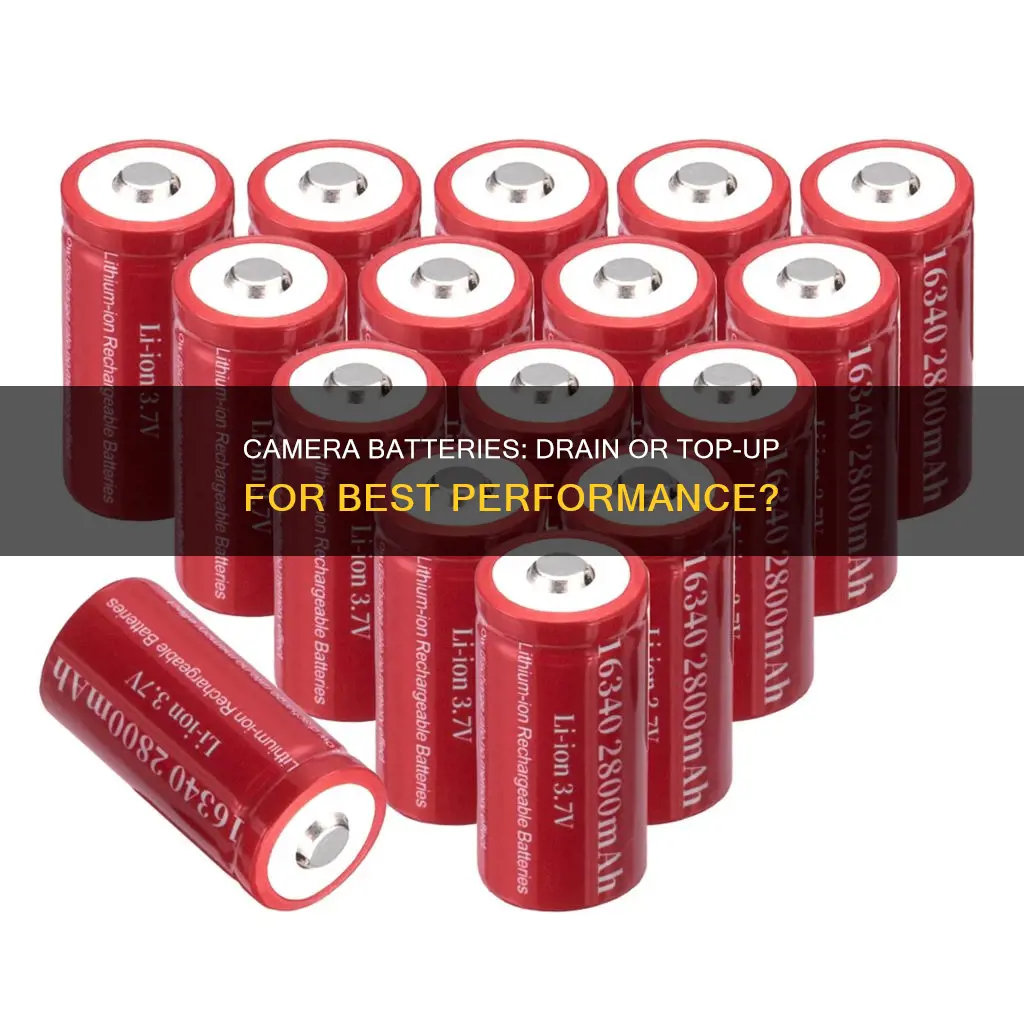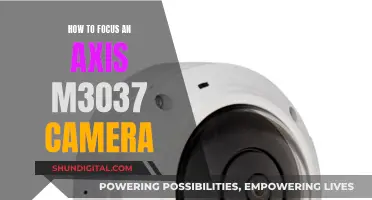
There is a long-standing debate about whether camera batteries should be fully drained before recharging. Some older nickel-cadmium (Ni-Cad) batteries used in satellites required complete drainage to avoid the memory effect, which reduced battery capacity. However, modern camera batteries, particularly lithium-ion (Li-ion) ones, do not exhibit this effect. In fact, fully discharging Li-ion batteries can harm their lifespan and performance. Therefore, it is recommended to recharge them when they reach around 10% to 20% charge, and store them in moderate temperatures to maintain optimal performance.
| Characteristics | Values |
|---|---|
| Should camera batteries be fully drained before recharging? | No |
| Types of batteries that need to be fully discharged | Ni-Cad, NiMH |
| Types of batteries that should not be fully discharged | Lithium-ion |
| Reason for fully discharging Ni-Cad and NiMH batteries | To minimise the "memory effect" |
| Reason for not fully discharging lithium-ion batteries | To avoid damaging the battery and reducing its lifespan |
| Recommended charge level for recharging lithium-ion batteries | Around 10% to 20% remaining |
What You'll Learn

Lithium-ion batteries vs. Ni-Cad batteries
It is not necessary to fully drain camera batteries before recharging them. In fact, doing so can be harmful, especially for Lithium-ion (Li-ion) batteries.
Lithium-ion batteries are smaller, lighter, and provide more energy than Nickel-cadmium (NiCad or Ni-Cd) batteries. They are also lower maintenance, and can be recharged before they are fully discharged without creating a "memory effect". This means that they can operate for a wider range of temperatures and can be stored for months without losing their charge. They are also safer for the environment, as they do not contain toxic heavy metals.
However, the main drawback of Lithium-ion batteries is that they are more fragile than Ni-Cad batteries, and they require a protection circuit to maintain safe operation. They are also more expensive.
Ni-Cad batteries, on the other hand, are more robust and can withstand extreme temperatures. They also have a longer life cycle than Lithium-ion batteries. However, they suffer from the memory effect, which means that if they are not completely charged after each use, they will only charge up to the last highest charge. This can shorten the lifespan of the battery. Ni-Cad batteries also contain toxic heavy metals, which require special care during disposal.
Charged Camera Batteries: Marking Them Efficiently
You may want to see also

The memory effect
The term "memory" originated from an aerospace application where nickel-cadmium batteries were repeatedly discharged to 25% of their capacity and then recharged to 100% without overcharging. This long-term, repetitive cycle caused a loss of capacity beyond the 25% discharge point.
True memory cannot exist if any of the following conditions are met:
- Batteries achieve full overcharge.
- Discharge is not exactly the same each cycle, varying by more than 3%.
- Discharge is to less than 1.0 volts per cell.
While lithium-ion batteries do not suffer from the memory effect, they can experience a similar issue. Lithium-based cells may change their voltage levels, leading to a perceived decrease in capacity by the battery control system. This is not a true memory effect but can cause similar issues with battery performance.
To avoid the memory effect in nickel-cadmium batteries, it is recommended to occasionally deep discharge and then recharge the battery. However, it is important to note that modern batteries, including lithium-ion batteries, do not require full discharge before recharging and are not affected by the memory effect in the same way.
Charging Casio Exilim: A Step-by-Step Guide
You may want to see also

Charging methods
When it comes to charging your camera battery, it's important to dispel a common misconception: you do not need to fully drain your camera battery before recharging it. This notion stems from the "memory effect" observed in certain nickel-cadmium (Ni-Cad) batteries used in satellites, but it does not apply to modern camera batteries, particularly lithium-ion (Li-ion) batteries, which are now prevalent in most cameras.
- Avoid Fully Discharging: Contrary to the "memory effect," fully discharging Li-ion batteries can be harmful to their overall lifespan and performance. It is recommended to recharge your camera battery when it reaches around 10% to 20% charge remaining, as indicated by the low charge indicator on your camera.
- Initial Full Charge: When you receive a new DSLR with a lithium-ion battery, it is advisable to charge it fully before using it for the first time. This initial charging process typically takes about two hours.
- Avoid Overcharging: While modern chargers have overcharge protection, it is still best to remove the battery from the charger once it is fully recharged. Leaving the battery connected for extended periods, especially at higher temperatures, may lead to issues due to self-discharge.
- Overnight Charging: While occasional overnight charging may not cause significant harm, consistently doing so or aiming for maximum battery life may warrant adjusting your habits. It is better to charge before bedtime and remove the battery once it is fully charged.
- Storage: If you don't plan on using the battery for an extended period, it is recommended to recharge it to about 80% capacity and store it in a cool, dry, and well-ventilated environment. Avoid extreme temperatures, as they can affect the battery's performance and longevity.
- Calibration: Once in a while, it is beneficial to allow the battery to drain until the camera refuses to work. This helps the control circuits adjust to the current capacity of the battery, ensuring more accurate battery capacity displays.
- Partial Discharges: For lithium-ion batteries, several partial discharges with frequent recharges are better than one deep discharge. Recharging a partially charged lithium-ion battery does not cause harm due to the absence of the memory effect.
- Avoid Heat: Heat is detrimental to lithium-ion batteries. Avoid charging or storing your battery in high-temperature environments, as it can accelerate capacity loss and shorten the battery's lifespan.
- Correct Charger: Always use the supplied power cable, AC wall adapter, and designated charger that came with your camera. Using incorrect or incompatible chargers may damage your battery.
TCL DV007: What's the Camera's Charger Port Type?
You may want to see also

Battery maintenance
As an avid photographer, you understand the importance of a well-maintained DSLR camera, and that includes caring for its battery. Proper battery maintenance is crucial to ensuring your camera performs reliably and capturing those precious moments without interruption. So, let's dive into the best practices for extending the life of your camera's battery.
This is a common question among photographers, and the answer may surprise you. Contrary to popular belief, you should avoid fully draining your camera battery before recharging. This practice is a misconception stemming from the "`memory effect`" observed in certain nickel-cadmium (Ni-Cad) batteries used in satellites. However, modern camera batteries, particularly lithium-ion (Li-ion) batteries, do not exhibit this memory effect.
Lithium-ion Batteries
Li-ion batteries, which are commonly found in today's cameras, should not be fully discharged. Doing so can actually harm their overall lifespan and performance. These batteries have a finite number of charging cycles, and frequent full discharges will reduce their longevity. Additionally, Li-ion batteries have a safety circuit that prevents them from being recharged below a certain voltage, typically around 2.50V/cell.
Best Practices for Charging
It is recommended to recharge your Li-ion camera battery when it reaches around 10% to 20% charge remaining. This will help maximize the lifespan of your battery. Always use the designated charger and power cable provided with your camera, and avoid overcharging or leaving the battery connected to the charger overnight. While modern chargers have overcharge protection, prolonged connection may still lead to issues due to self-discharge, especially at higher temperatures.
Battery Storage and Handling
Proper storage and handling of your camera battery are also essential. Avoid exposing the battery to extreme temperatures, both hot and cold, as this can affect its performance and longevity. When not in use for extended periods, remove the battery from your camera and store it in a dry, well-ventilated area. Additionally, try to keep the battery charge between 10% and 80% during storage.
Other Tips for Extending Battery Life
In addition to proper charging and storage practices, there are a few other things you can do to maximize your camera's battery life:
- Minimize the use of the LCD screen.
- Avoid using larger lenses, which require more power.
- Turn off continuous autofocus mode when not needed.
- Limit excessive shutter button presses.
- Only use the automatic flash when necessary.
- Deactivate features that are not required for your current shooting conditions.
- Remember to switch off the camera when not in use.
- Avoid shooting in RAW format unless necessary, as it consumes more power.
- Always charge your battery before important shoots to ensure it's at its optimal capacity.
Camera Care
In addition to battery maintenance, proper care of your camera is crucial to ensure its longevity:
- Handle your camera with care, avoiding strong shocks or vibrations.
- Keep your camera dry and avoid water exposure or high humidity to prevent rusting.
- Protect your camera from sudden temperature changes, as they can cause condensation. Use a carrying case or plastic bag when moving between extreme temperatures.
- Avoid leaving your camera lens pointed directly at the sun for extended periods to prevent damage to the image sensor.
- Clean your camera gently with a blower and a soft, dry cloth. For sandy or salty environments, use a lightly dampened cloth with pure water.
By following these battery maintenance and camera care tips, you can ensure your DSLR camera and its battery remain in optimal condition. Happy shooting!
The Ultimate Guide to Charging Your Doorbell Camera
You may want to see also

Camera battery life
Contrary to popular belief, it is not necessary to fully drain camera batteries before recharging. In fact, doing so can be harmful to the battery's lifespan and performance. This misconception stems from the "'memory effect' observed in older nickel-cadmium (Ni-Cad) batteries, which is not present in modern lithium-ion batteries.
Lithium-ion batteries should be recharged when they reach around 10% to 20% charge remaining. Overnight charging is generally not recommended as it can decrease the battery's performance and longevity. Additionally, it is important to avoid extreme temperatures when storing the battery to maintain its functionality.
To optimize battery life, it is advisable to avoid actions that drain the battery unnecessarily, such as excessive use of the LCD screen or keeping the autofocus on continuous mode. Proper camera and battery care, such as handling with care, protecting from water and extreme temperatures, and gentle cleaning, can also contribute to maintaining optimal battery performance.
In summary, modern camera batteries do not require complete drainage before recharging. By following the recommended charging practices and taking proper care of the camera and battery, photographers can ensure reliable performance and prolong the lifespan of their equipment.
Keep Your Camera Charged: Tips to Conserve Battery Power
You may want to see also
Frequently asked questions
No, it is not necessary to fully drain camera batteries before recharging them. In fact, doing so can be harmful to the lifespan and performance of certain battery types.
The "memory effect" is a phenomenon observed in certain nickel-cadmium (Ni-Cad) batteries where, if the battery is not fully charged and discharged for long periods, traces are left in the battery, leading to reduced capacity.
No, lithium-ion batteries do not exhibit the "memory effect". They can be charged and used as needed without worrying about diminishing their capacity.
It is recommended to recharge your camera battery when it reaches around 10% to 20% charge remaining, as indicated by the low charge indicator on your camera.
Yes, avoid overcharging or leaving the battery connected to the charger overnight, as this can potentially damage the battery. Additionally, avoid storing the battery in extreme temperatures, both hot and cold, as it can affect its performance and longevity.







